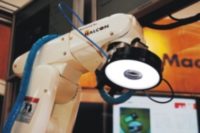Quality Headline
Education: Technical University of Applied Sciences Würzburg-Schweinfurt Relies on MVTec HALCON for Academic Training

At Technical University of Applied Sciences Würzburg-Schweinfurt (THWS), Professor Christian Zirkelbach is teaching robotics and machine vision at Faculty of Applied Natural Sciences and Humanities. He has integrated advanced machine vision tools into its robotics curriculum, leveraging MVTec HALCON software since 2019. We’ve talked with him about the most recent project in robotics education.
Q: How did you come to incorporate MVTec software in your teaching and research?
Zirkelbach: Our faculty has adopted state-of-the-art technology to advance its educational and research initiatives. The institution began its journey with MVTec HALCON in 2019, marking a pivotal step in incorporating the sophisticated machine vision tool into our curriculum.
HALCON supports a wide array of cameras and offers numerous algorithms for understanding 3D images. That’s the reason why we’ve chosen HALCON for our educational and researching purposes.
Q: What use case for machine vision software do you have within your project?
Zirkelbach: One of THWS's standout projects features a 7-axis MRK robot, the KUKA iiwa, programmed to play chess on a physical board with the aid of stereo cameras and HALCON. This project highlights the practical application of machine vision in robotics.
In this endeavor, HALCON's robust capabilities were employed for various tasks such as identification, robot vision, and position recognition. Techniques like matching, classification, and blob analysis were utilized to enable the robot to understand and interact with its environment, effectively giving it "eyes" to navigate and make decisions.
Q: What impact does the integration of MVTec HALCON have on education and research at THWS?
Zirkelbach: Integrating MVTec HALCON into the THWS curriculum has yielded numerous benefits. It has not only added practical relevance to our lectures but also spurred the development of innovative research projects. The ability to give a robot eye to understand and interact with its environment has been invaluable. Feedback from students and the research team has been overwhelmingly positive, highlighting the enhancement in learning and research capabilities.
The project's success was further validated when Bavarian Prime Minister Markus Söder visited the installation. An event that garnered media attention and underscored the institution's commitment to technological advancement.
Q: What makes the student-driven masterpiece at THWS using MVTec HALCON stand out?
Zirkelbach: This groundbreaking work was realized through a master's thesis project by a dedicated student, emphasizing the hands-on learning approach promoted at THWS. The MVTec on Campus program has proven to be instrumental in providing students with the tools and knowledge necessary to excel in machine vision and robotics.
Through the utilization of HALCON, Technical University of Applied Sciences Würzburg-Schweinfurt continues to push the boundaries of robotics and machine vision, preparing the next generation of engineers and researchers to lead technological innovation.
Q: Which advantages result from the participation in the MVTec on Campus program?
Zirkelbach: Integrating MVTec HALCON into our robotics curriculum has significantly enhanced our educational and research capabilities, exemplified by projects like the chess-playing robot.
Moreover, our students are getting effectively prepared to be leaders in the fields of robotics and machine vision by hands-on learning.
For more information, visit www.mvtec.com.
Looking for a reprint of this article?
From high-res PDFs to custom plaques, order your copy today!





